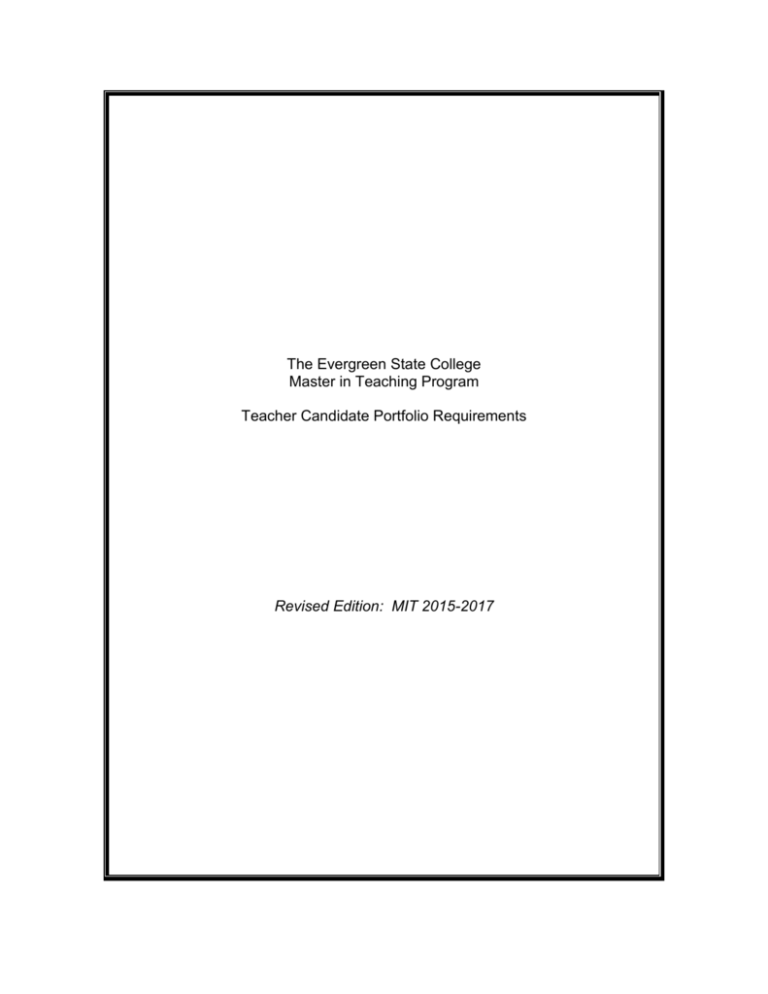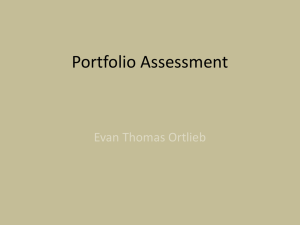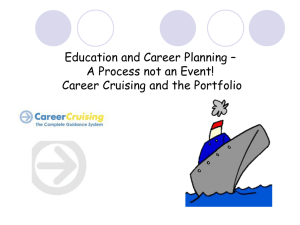The Evergreen State College
advertisement

The Evergreen State College Master in Teaching Program Teacher Candidate Portfolio Requirements Revised Edition: MIT 2015-2017 Portfolios: Why Do We Use Them and What ARE They? Faculty members in the Master in Teaching Program choose to use portfolios as learning and assessment tools for three major reasons: Evergreen has an established history of using journals, program portfolios, and self-evaluation as an important aspect of encouraging reflective, selfdirected learning. The State of Washington has been involved in an extensive education reform movement since 1993 that focuses on the ability of students to DEMONSTRATE what they have learned. Portfolios are one of the assessment tools that public school teachers need to be able to use effectively to help students demonstrate what they know and can do. As a faculty team, we believe that the selection/reflection aspect of the portfolio process we use is crucial for developing reflective, active learners who understand what they know and what they need to learn. These portfolios are a documentation of your growth and development as a teacher who understands “teacher impact on student learning” as required by the state of Washington WAC 181-78a-270(5), Standard V. You will be doing writing of one kind or another during the next two years. You will be writing in preparation for seminars, keeping a journal of field observations in classrooms, preparing drafts and rewrites of educational philosophy papers, compiling notes about how to use computers, the library, and media, drafting your autobiography, completing exercises for workshops, and writing selfreflections of various kinds. Additionally, as you begin to do research for your Master's Paper, you will be collecting bibliographic references, ideas, copies of articles, annotations, etc. All of these materials should be saved in organized files for reference, easily accessed when you are ready to create your formal portfolios, and available for review by faculty (hint: they will be turned in!). Formal Program Portfolios – Each Teacher Candidate will create four formal portfolios that will reflect her/his progress at various points in the program. The portfolios will be used in two ways: These portfolios will provide you with a means of reflecting about what you already know, and what you learn during the program -- about yourself as a teacher/learner; about children and adolescents; about teaching, and about what you know in the subject areas you want to teach. They also will give you an opportunity to reflect on what you still need to work on. These portfolios will also provide faculty with demonstrations of what you have accomplished and what you know relative to teaching and learning so that your work may be evaluated and decisions made about Advancement to Candidacy, preparation for student teaching, certification, and the award of the Master in Teaching degree. These portfolios also provide faculty with demonstrations of what you have accomplished and what you know relative to the State Standards (see Standard V) for teaching and learning so that your work may be evaluated and decisions made about Advancement to Candidacy, preparation for student teaching, certification, and the award of the Master in Teaching degree. As the time approaches to prepare each of these portfolios, you will receive a separate outline of the skills, knowledge, attitudes and dispositions that you must document. You will need to review the work you produced during the program and collected in your informal portfolio files, to select which pieces of your work best demonstrate the specified areas of skill, knowledge, attitudes and behaviors. Once your selections are made, you will write reflective essays about your work that discuss: the type of growth demonstrated by your selections, how and why you think the growth occurred, why these particular choices are good representatives of your work, why they support either a) your application for Candidacy, b) your readiness to student teach, or c) your application for employment. The portfolios you will develop in the program are as follows: A. Advancement to Candidacy Portfolio - This is the first formal portfolio you will assemble. It is due at the end of the first quarter and will be the basis for your evaluation conference. The material in the portfolio will be evaluated as a part of your demonstration of readiness for Advancement to Candidacy. Advancement to Candidacy signifies that you have demonstrated the disposition, competencies, and knowledge necessary to successfully complete graduate level work. It is a major determining factor in whether or not you will advance in the program. An assessment of your ability to help children and adolescents achieve the learning goals specified in the Washington State K-12 Learning Standards and Guidelines is required in this portfolio. B. Advancement to Student Teaching Portfolio - You must submit this second formal portfolio near the end of the third quarter, Spring 2016, prior to your student teaching in the fall. Four important parts of this portfolio are: demonstrations of your ability to plan effective, developmentally, and culturally appropriate learning experiences that reflect the appropriate Washington State K-12 Learning Standards and Guidelines demonstrations of your understanding of cultural encapsulation and your efforts and strategies to monitor your own cultural filters demonstrations of your discipline regarding the three program themes: 1) democracy in schooling, 2) social justice and multicultural theory and practice; and 3) developmentally and socioculturally appropriate teaching and learning; as well as anti-bias leadership and commitment to making change in the classroom, your school, and the community your Master's Paper C. Presentation Portfolio - As a part of your work during the first quarter of student teaching, you will be planning lessons/units keyed to Washington State K-12 Learning Standards and Guidelines and demonstrating your ability to have a positive impact on student learning. In addition, you will be keeping a reflective journal about your teaching and you will have opportunities to assess your students' performances. These materials, as well as photographs of your classrooms and video of yourself teaching, will provide rich material for the development of a "presentation portfolio" of your own design. This portfolio will give you an opportunity to assemble your best work and reflect on your strengths and creativity as an emerging teacher, as well as areas you need to strengthen. This portfolio is due Week 10 of the Fall Quarter student teaching. D. Professional Presentation Portfolio –This portfolio introduces you to potential employers. You will use this final portfolio, which is due during the last program quarter, Spring 2017, as a professional reflection of your work. It will include a letter of introduction, revised resume, a revised philosophy of education statement, as well as pieces of your work selected by you, to represent your unique skills and competencies for teaching. In preparation for developing your portfolio, during Winter Quarter of Year Two, you will have opportunities to talk with teachers and principals, have a mock interview with a principal, and read current literature on the use of professional portfolios.







